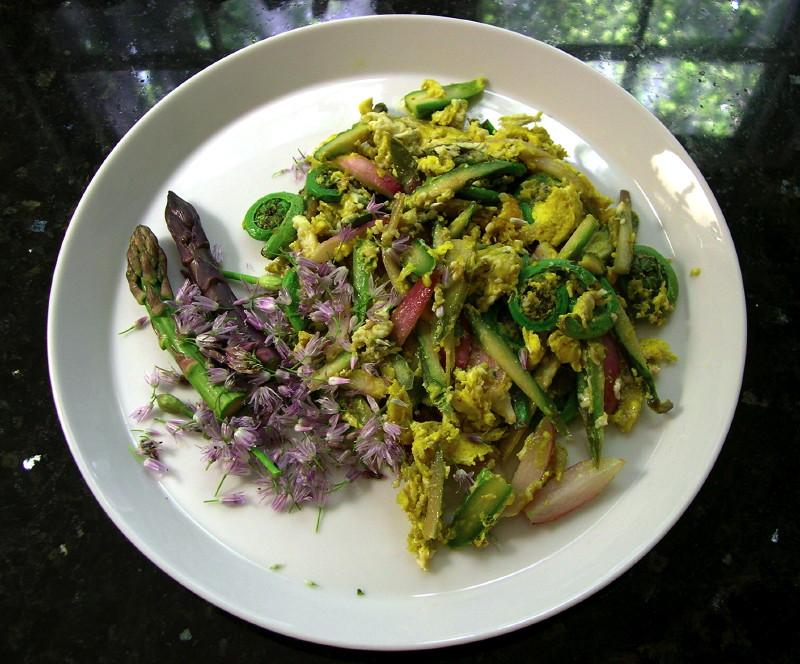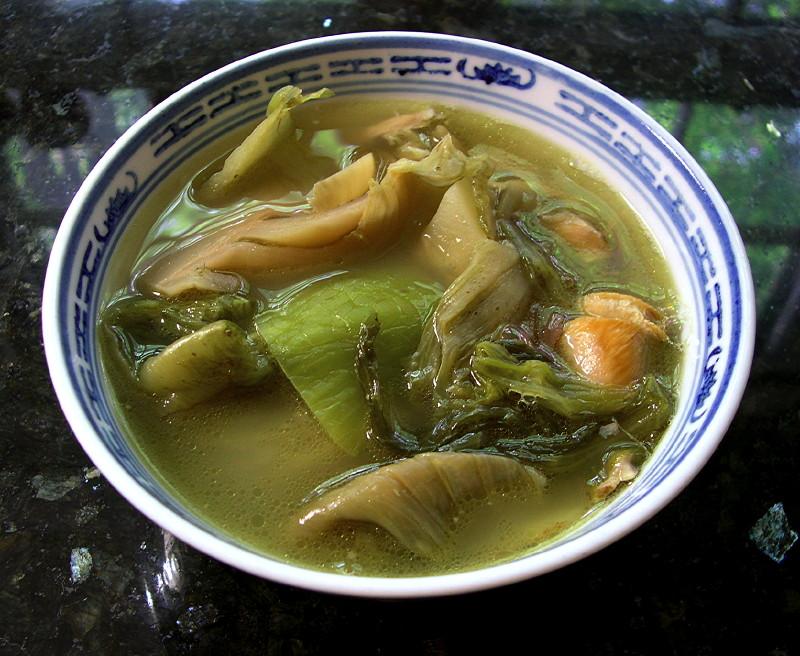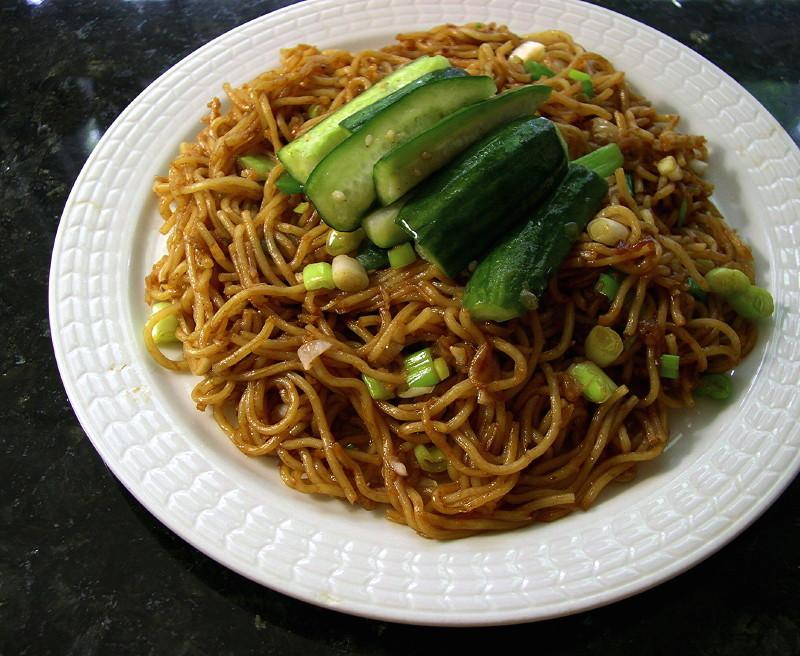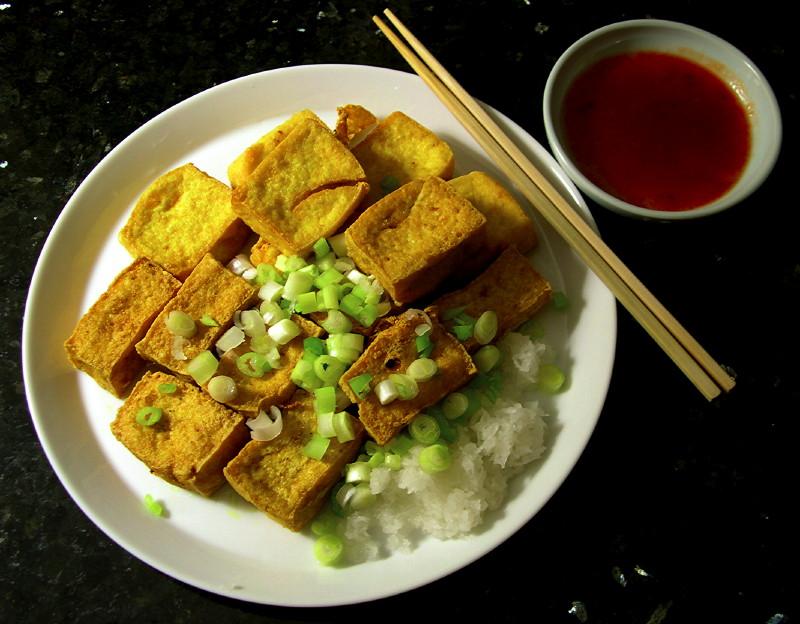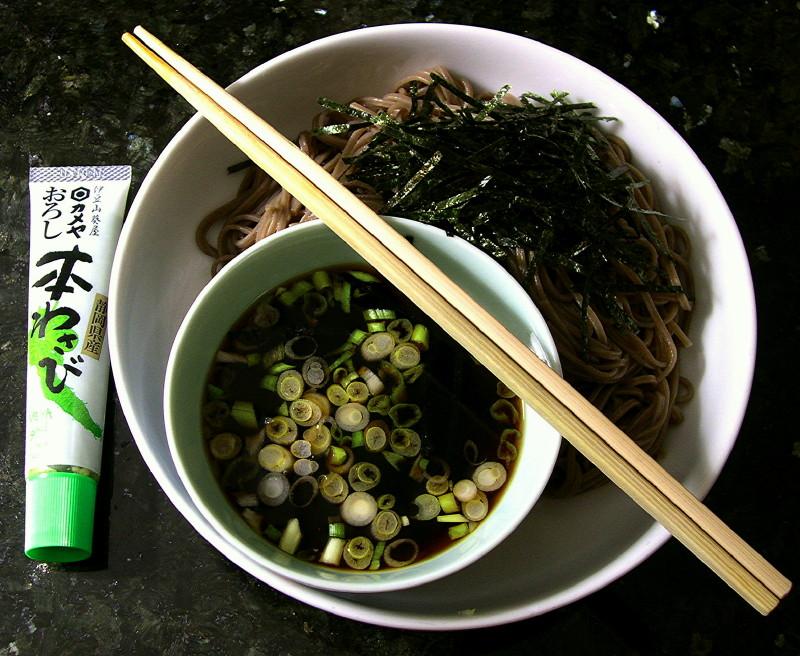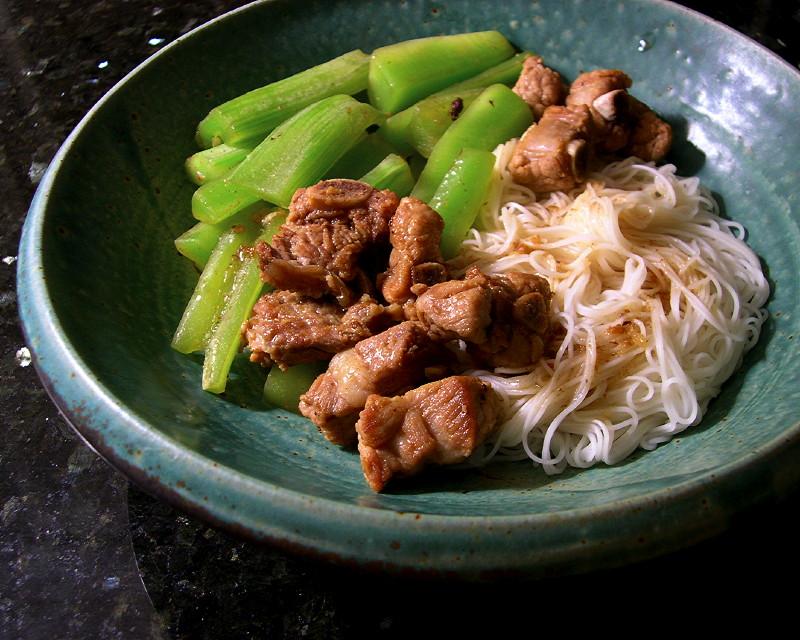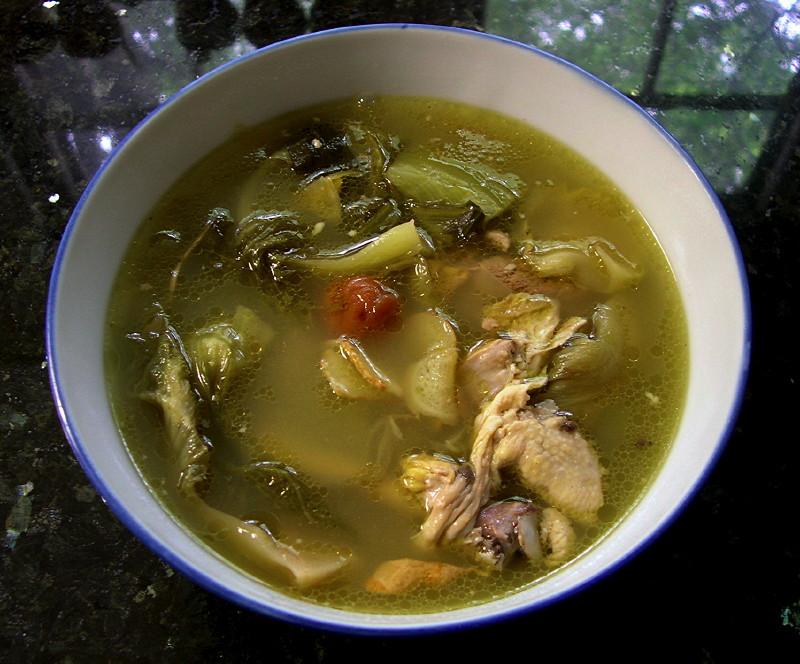-
Posts
3,810 -
Joined
-
Last visited
Content Type
Profiles
Forums
Store
Help Articles
Everything posted by huiray
-
Those bean curd knots are commonly available in Chinese groceries in the USA, alongside various other forms of bean curd skin that you presumably know of.
-
The pectoral fins look lobed/rounded rather than pointy which the weever seems to have? Hmm, the spotted skin (which is still visible) and the mouth and the eyes and the rounded pectoral fins and just the general appearance of the dish is reminiscent to me of garoupa...the black/grey ones, not red...like this, or this...or this (from here)...but of course that is just another possibility.
-
• Fiddleheads, green asparagus, purple asparagus, French Breakfast radishes, oil, salt, local fresh eggs scrambled in situ. Chive flower florets. • Andouille sausage meat, brown beech mushrooms, sliced spring onions, corn oil, salt. Tossed in pan w/ fresh radiatore [Nicole-Taylor's]. Grated raw daikon & sliced scallions.
-
Not sure about the Northern Indian stuff; but for E/SE Asians dishes that I cook I tend to use cassia cinnamon when I do use it in them. Having said that, there are (as you have found) different varieties of cassia cinnamon. :-) I don't particularly distinguish them by exact regional derivation. I tend to look for and buy the thinner, smaller quills that roll in on themselves from both sides, as opposed to the ones that roll in from one side only - which seems to be the characteristics also of the BIG, thick-layer-bark quills which I tend to use last or when I run out of the thinner smaller ones. The big thick ones I also find tend to leave a noticeably "woody" taste in, say, something like a pot of Bak Kut Teh if I leave the sticks in when leaving the pot overnight (i.e. allowing the sticks to continue to infuse the soup) (perhaps not surprising) besides intensifying the cinnamon-y taste as well, so I typically fish them out after cooking is completed. The small thin ones I can leave in. As for "intensity of taste"/sweetness/etc I judge the overall effect of the dish with all the various components (I would seldom - nay, never - use just cinnamon by itself in a dish as the only flavoring/spicing agent, for example) and add stuff as needed including gula melaka, rock sugar, mirin etc etc (w.r.t. the "sweetness" component, for example); or even remove a stick of cinnamon if I find the dish is getting a little "heavy" on the aroma as the dish is cooking along... All this is my personal practice, others may do different things. I can't remember the last time I bought powdered cinnamon although I'm sure I must have done it at least once in the far distant past.
-
• Leftover pickled mustard soup (from here). • Nama-yakisoba [Maruchan] pan-fried w/ the sauce/seasoning sachet(s) and lots of chopped scallions. Eaten with Japanese cucumbers pickled w/ rice vinegar, hon-mirin, a bit of ryori-shu, toasted sesame seeds & wasabi fumi furikake.
-
Two-thirds of a block of soft tofu and one block of firm tofu, both cut into chunks, deep-fried in turmeric-infused oil.¶ The tofu picked up an additional pleasant taste to the crispy skin and a lovely golden color, over how they come out when done in a more usual manner. Eaten w/ chopped scallions and grated daikon. Dipping sauce of a mixture of Lingham's Hot Sauce & nước mắm pha sẵn. ¶Oil that had been used to deep-fry the tamarind-marinated chicken pieces when making Kari Kapitan previously posted about here.
-
A skew in the items that are stocked on the shelves, tending towards materials/items from a specific place - in their case, from South Korea.
-
In other words, it sounds like a General Store. Not a "Korean Health Food Store". It's a store that just happens to be owned by a Korean couple. Would you have called it a Russian Health Food Store if it happened to be owned by a Russian couple where they sold all sorts of European stuff besides stuff from their own place of origin plus a smattering of stuff from North Africa, say?
-
For deep-frying (i am, in fact, doing this as we speak/write) I tend to use vegetable oil/corn oil/canola oil. Using olive oil is SUCH A WASTE in my opinion, unless one were independently wealthy and/or of such substantial financial resources that such things did not matter.
-
This post and those responding to it have been moved from here. Doubtless. I still wonder, though, about going to a Korean store as the first port of call... just my thoughts. Even in the Hanareum megastores in NJ that I visited occasionally when I lived in NJ they were loathe to stock much in the way of Chinese or Japanese stuff (other than Korean, that is) let alone SE Asian stuff. I would have tried a Chinese grocery or an "Asian" grocery first...or Vietnamese... rather than a specifically Korean grocery... just sayin'. Of course, if the only E/SE Asian grocery near you was a Korean grocery then that is perfectly understandable... :-) ETA: It's just my personal experience, but I have also not noticed Korean groceries elsewhere in places I've lived in (including my present location) stocking much beyond Korean and Japanese stuff, with limited Chinese things. Rarely other stuff from SE Asia. By the same token, I don't see very much Korean stuff in specifically Chinese groceries, with some exceptions. ETA2: I suppose this might also be an illustration of why the coverall word "Asian" is really meaningless, as I have harped upon (as some here will say) without a baseline definition of what one is referring to. ETA3: I pointed out the skew in the stocking to a friend I was visiting such a Hanareum store with, who had visited such stores whenever she wanted "Asian stuff" and it turned out she had (like many other folks) assumed that "Asian" and "Korean" meant much the same. She had not thought about the differences between Chinese stuff, let alone Cantonese versus Szechuanese versus Shanghainese stuff (they were all the same to her) and in a general sense had also considered "Korean" stuff to be equivalent to anyothersortof Asian stuff. ETA4: And we are not even getting into "Indian" stuff.
-
Well, if one noted the name of the stuff on the package that Anna N posted, one would see "Emping Manis Pedas", which is MALAY, not Korean. p.s. "Padi" is also a Malay word, meaning rice - as still growing on the plant in the field.** p.p.s. "Emping"¶¶ (in older-style Malay, properly "ĕmping") itself means "young rice crushed and cooked" (Winstedt) **ETA: versus "nasi", which would be "rice" after it has been harvested and processed (and cooked, in most contexts) ¶¶ Google translate gives it as "flakes" which is not quite right.
-
No, I applaud any restaurant or barkeep or similar person-in-charge to request (strongly, if needed) intending patrons to remove their Googleglass. BTW, my post above referred to exactly what you post about but I assume you are just elaborating upon it.
-
Heh, well, you both would be traveling together, no? (now that you mentioned that "ferry north" - to Manitoulin Island?) Do keep in mind that it's just a "traditional belief"/superstition.
-
Asking for, being offered, drinking hot water is very common even in modern times in E/SE Asia even in the hottest weather. Many people still believe that it is deleterious to drink cold water, especially if it is hot outside. many of my older relatives did this too and shunned iced water when it was hot outside. Even for myself, drinking hot tea when I am simply thirsty is sometimes much more satisfying than a cold drink (I find it more "thirst quenching", which is commonly experienced by others too). Liuzhou also commented on one aspect/example of "ordering hot water" in China on his vegetarian cuisine in China topic. Those chopsticks of unequal length you both got should not have been given to you, unless the shop staff either didn't care or didn't notice. You should have asked for them to be replaced. (or just exchanged one stick with each other, if that would have resulted in getting two pairs that matched) It's a Japanese shop, so the following doesn't really apply (I think) but in Chinese tradition if one got an unmatched pair (unequal length) it meant that one was going to miss some sort of travel appointment - a boat trip, (and in modern times) a train, a plane...etc. Additionally, it's the wrong time of year for the Japanese Taishi-kō festival so I doubt "they" would have given you unmatched pairs to celebrate that, either, if they even did observe it when the time rolls around.
-
• Miso soup. Water, hon-dashi, cut wakame, soft tofu slices, aka miso, chopped scallions. • Soba (w/ yam). Dressed w/ kizami nori. Dipping sauce of hon-tsuyu, hon-mirin, water, ryori-shu (everything just brought to a boil then poured off, cooled), chopped scallions, izu oroshi-wasabi.
-
Ah. Well, the pinyin for "冰菜" ("ice vegetable") (see my post above) I believe would be bīng cài (Liuzhou might confirm that if it is correct) so that would seem to be consistent with what you remembered.
-
She's a vegetarian? Huh. V-E-R-Y good question about how she can judge all those meat dishes or meat-stock containing dishes etc etc etc, then. Maybe she just chews it a bit and tastes it but doesn't swallow and spits out everything that has meat in it? Would that satisfy the "requirements" for vegetarianism? Someone should ask her about it.
-
Could it be "冰菜", I wonder. It does look like it. Also known as Ficoïde glaciale (two articles on this here and here). Was it served cold or hot? Did the vegetable itself have the taste described in those two articles or was it muted/masked by the ginger dressing?
-
You may know about or have heard about these... Googlesearch1, Googlesearch2. Nice thread, nice to see the food you write about. The "greenery" you had twice (like this one you posted) looks like "water spinach" (Ipomoea aquatica) although what you had may be the cultivar that is grown on land. Various names in the dialects and in other cuisines given here.
-
Lettuce stems w/ short-cut pork spare ribs. Sautéed/stir-fried w/ lots of chopped garlic, salt, hon-mirin, shaohsing wine, drunken chicken marinade. Eaten w/ Fuzhou-type wheat noodles.
-
Here's a recent dust-up on Google reviews regarding a restaurant and the immediate effect on its rating due to one-star reviews from folks who had mostly never even eaten there: http://evgrieve.com/2014/05/a-google-glass-feast.html http://gothamist.com/2014/05/24/east_village_restaurant_asks_woman.php Many more links on the topic out there.
-
Soup. Pickled mustard, chicken drumsticks, sliced ginger, smashed garlic, salt, rice vinegar, mirin-fuu, umezuke.
-
Thanks, but I was really asking about what duck fat would cost if one bought it in your area (San Francisco)...i.e. un-branded, rendered duck fat in a tub. ETA: Other eGulleteers - what *would* it cost in SF, or in your own area, for this - when available? Again, it would be for un-branded duck fat in a tub. What about chicken fat?
-
I wondered about that. :-) You mentioned that you might never communicate with us again in a temporal sense when you described that phone call you got. :-D.
-
I picked up a 1 lb small tub of rendered duck fat from my local butcher for $9.99 last week. Clean, fresh, clear, clean-smelling stuff on melting some. How much is duck fat if one were to buy it in your area? (I don't mean the branded-jackeduppriced stuff from places like Williams-Sonoma/etc etc)



